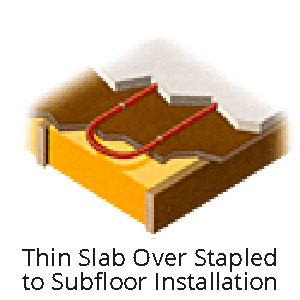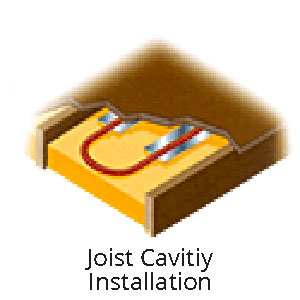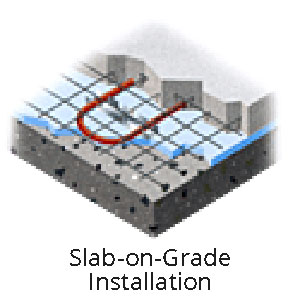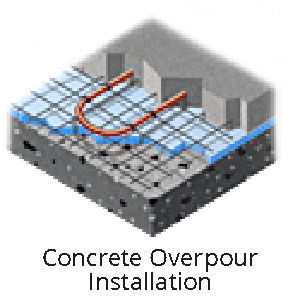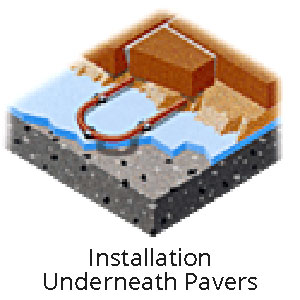
We install Rehau RAUPEX O2 barrier PEXa pipe, Rehau solid brass distribution manifolds and use Rehau brass connectors when installing our radiant systems.
We can repair and service other pex tubing systems, such as Wirsbo, Watts, Kitec, Vangaurd, Heat Link, Plasco and Onix.
How does it work?
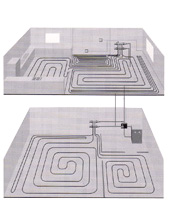
Imagine a cool, sunny spring morning; you’re walking along a tree-lined street. Every time you enter a sunlit space, it feels as though the temperature increases 5 degrees! When you stop to talk to a neighbour, you both naturally gravitate to an area out from under the trees because the feeling of sun is so luxurious!
That is Radiant heat in its finest, most common form. Radiant floors operate on the same principle: they heat objects, not air, by radiant energy, as opposed to convection. Outdoors, the sun is a high-energy thermal mass, and its energy waves pass invisibly through space until they reach a less energized surface, where they transfer their energy to the object, giving warmth. In a home, a hydronically or (electrically) heated floor is the thermal mass, and it conducts heat energy in the same way to your skin, to objects, to the room itself.
Why is this better? Because the comfort is much more uniform, less drafty, cleaner, quieter, and far more efficient. How is this so? Because forced air convection systems heat air and then blow it into a room. Distribution relies on the force of the air, the placement of the grille (usually under windows and near doors) and the size of the room. A high ceiling room takes much longer to warm because the lighter hot air gravitates to the top and “stacks” there, gradually filling the lower portions where your head (your “thermometer”) is located. Meanwhile at floor level, temperatures can be several uncomfortable degrees less. With radiant floors, the floor surface is warm, your feet are always comfortable and relaxed (no more foot cramps!) and your body’s thermostat is satisfied at lower actual temperatures – hence you feel brighter, more alert and not subconsciously disturbed by the continual falling and rising of air temperatures and waiting for the furnace to come on or turn off again.
At the top of the room, especially with cathedral ceilings, temperatures are much lower, so there is less wasted heat. The lower the temperature the lower the rate of heat loss, which means even greater savings. A large thermal mass, such as the concrete or gypcrete topping usually used in the radiant floors, provides a much more stable and consistent heat.
Radiant tubing can be easily embedded in a basement or on slab concrete floor, can be stapled over a new or existing sub floor and covered with a gypcrete over pour, or can be applied under the sub floor to heat the floor from below. All types of floor surfaces and coverings can be accommodated from thick granite or marble, to tile, ceramics, and linoleum, to all manner of composite or natural woods, to lightweight carpet and under pad. Radiant floors can be easily thermostatically zoned into many separate areas at a minimal expense (compare trying to zone your forced air system?) and controlled by means of adjusting the spacing of pipes water temperature, flow rate, and on-off times. There is no dust or pollen carried by drafty air, no blackened rugs near vents, no filthy return air grilles on walls or floors.
Radiant floors can be heated by several means, depending on size and location. A simple domestic hot water heat can handle a couple of rooms; one of several new “combo” hot water heaters can heat both domestic hot water and the entire house of radiant floors; traditional or high efficiency boilers are readily available with or without domestic water features. Because radiant water temperatures are abnormally low (100-130 degrees Fahrenheit), ground source heat pumps, or even solar heating panels can be used. All manner of fuels can be used, including gas, propane, oil, wood, or electric. And since hot water as a heating medium is extremely adaptable, during the summer when the radiant floors are no longer needed, you can turn a valve and direct the flow of hot water to a heat exchanger to heat your pool, Jacuzzi, or hot tub!.
Radiant floors, because of the thermal mass, are more stable structurally, and far less sound travels through, a key feature in two story family dwellings. Concrete as a foundation or floor structure saves on construction costs and offers better protection against moisture and radon gas intrusion Radiant floors offer the most adaptability in the interior, as there are no ducts to hide and no vents, grilles, or radiators, to restrict furniture locations or decoration.
Radiant driveways (also known as “Snowmelting”) are gaining in popularity for those who are sick of the early winter morning shoveling drudgery, and a necessity for severely sloped driveways and underground garage entrances. More information on snowmelting
What are the limitations of radiant floors? The planning of walls and structural elements is more critical because buried pipes are difficult to relocate if future renovations are required. While all floor surfaces are compatible, decisions such as how thick the carpet and under pad, or how the wood floor will be attached, can be of significance to the overall design. Systems must thoughtfully planned with respect to controls, to minimize “lag time” necessary to bring a cold initial investment for a complete radiant floor system could be double the cost of a simple sheet metal duct work and furnace system. Air conditioning normally a simple add on to duct work systems, can usually be easily installed in the attic of the dwelling, delivering cool air from above – which makes the most of its natural tendency to fall. SpacePAK and LO-VELO are two such systems.
In summary, any restrictions are far surpassed by the convenience, stability and comforts, cleanliness, quietness, consistency, adaptability, zone-ability, efficiency and economy. Controls such as Tekmar and Taco can add multiple capabilities to your radiant systems operation and efficiency. Invest in your own well being and reap continual, measurable, and gratifying rewards for years to come.

